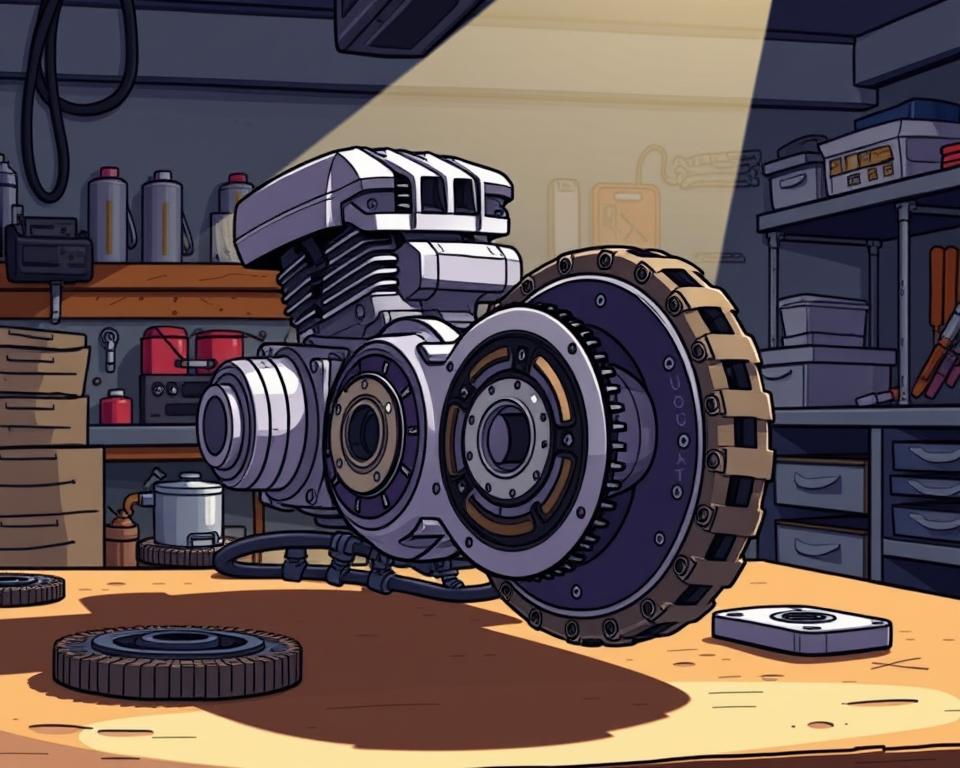Steering Clear of ATV/UTV Gearing Errors for Novices
It’s interesting to note that nearly 20% of new ATV and UTV owners face gear selection issues within their first year? This statistic underlines the importance of grasping ATV gear ratios for beginners. Beyond performance, proper gearing is a key safety factor. In this guide, we cover typical errors, upkeep tips, and pro Can Am speaker roof recommendations for better trail experiences.
Essential Insights

- Knowing gear ratios is crucial for peak off-road power.
- Neglecting gearing details increases accident hazards.
- Scheduled upkeep stops gearbox failures.
- Proper gear selection greatly enhances off-road riding experiences.
- Following upkeep advice extends your ATV’s life.
Understanding ATV and UTV Gear Ratios
ATV/UTV gear ratios dictate how power meets torque. They govern both top speed and hauling capacity. This affects acceleration and the vehicle’s ability to pull loads. Custom gearing shifts focus from speed to torque or vice versa.
Selecting proper gears unlocks engine potential. Too low a ratio may leave you underpowered on inclines. Overgearing sacrifices quickness for top-end speed.
Adjusting reduction influences handling in mud, sand, and rock. Ratio mods shape how your rig behaves off-road. This ensures the machine operates efficiently, whether prioritizing speed or torque. Achieving the right balance in ATV gear ratios improves the driving experience and boosts efficiency.
Common Gearing Oversights for New ATV/UTV Owners
Proper gear choice underpins both power and protection. First-timers frequently ignore ratio considerations. Knowing what happens when you misgear and how to fix it transforms your experience. It also helps avoid issues.
Impact of Incorrect Gear Selection
Choosing the wrong gear can lead to serious problems, including loss of control and mechanical failures. Poor gear choice dampens speed, stresses brakes, and accelerates wear. Such errors endanger everyone, from driver to bystanders. Using maintenance best practices wards off these hazards.
Choosing the Right Gear for Terrain
Different terrains need different gearing for efficient performance. Climbing requires low-end grunt from smaller ratios. On flat terrains, higher gears help increase speed. Mucky surfaces require cautious gearing to maintain momentum. Understanding trail types secures fun and safety.
The Importance of Proper ATV Maintenance
Regular maintenance is key to keeping ATVs and UTVs running smoothly. Using upkeep best practices stops breakdowns and protects riders. A smart maintenance regimen targets gearbox longevity.
Regular Inspection and Maintenance
Using a checklist uncovers faults before they escalate. Routinely examine gearbox teeth, brake pads, rubber, and belts. Routine checks lead to peak performance. Here are some critical inspection points to remember:
- Examine gear alignment and wear.
- Verify hardware and linkages are secure.
- Assess brake fluid and hydraulic systems.
- Measure wheel pressure and wear.
- Inspect battery terminals and cables for buildup.
Fluid Changes and Gear Health
Clean fluids keep transmissions and differentials happy. Routine fluid swaps avoid sludge and varnish. Clean fluids ensure smoother operation and reduce friction, extending the life of vital parts. Using this method secures dependable function and fewer breakdowns.
| Fluid Type | Recommended Change Interval | Benefits of Regular Change |
|---|---|---|
| Engine Oil | 50–100 operating hours | Cuts friction and boosts power |
| Differential Oil | 100–200 operating hours | Smooths shifts and prevents pitting |
| Coolant | Once per year | Prevents overheating, maintains optimal temperature |
By following these guidelines, enthusiasts can enjoy their rides without worrying about mechanical failures. That boosts confidence and enjoyment.
Common ATV Gear Shifting Problems
Rookie riders struggle with smooth shifts. Mastering smooth shifting techniques can greatly improve the riding experience. It reduces frustration on the trails. Proper coordination of the throttle and clutch is key for control and avoiding shifting problems.
Learning to Shift Smoothly
Building graceful shift habits demands consistent effort. Begin by listening to your motor’s cadence. Smooth gear engagement reduces transmission stress and prevents issues. Matching revs while you let out the clutch is essential.
Practice shifting in a controlled setting until you’re confident. Focus on gentle throttle application during each gear change.
Recognizing Signs of Gear Issues
Spotting problems early prevents breakdowns. Watch for whines, clanks, or crunches in the gearbox. Difficulty shifting can also signal problems that need quick attention. Addressing issues promptly protects components and riders. Addressing ATV gear shifting problems properly maintains vehicle performance and boosts your confidence while riding.
Understanding UTV Transmission Issues
Transmission headaches are common; understanding them aids fixes. Frequent complaints include gears that pop out and strange whines. Here we examine usual faults and outline a step-by-step fix plan. Leveraging user-friendly diagnostic procedures.
Diagnosing Common Problems
Recognizing the signs of transmission troubles is essential. Common issues include:
- Gears that pop out under load, risking accidents.
- Strange noises signaling internal wear.
- Leaking transmission fluid, potentially leading to more severe problems.
Regular gear diagnostics help spot these issues quickly. It lets you fix faults before they worsen. Missing early clues damages your ride and wallet.
Solutions for Troubleshooting UTV Transmissions
Repairing gearbox problems calls for methodical steps. Follow these steps for effective troubleshooting:
- Ensure gearbox fluid is at spec, then add if low.
- Inspect pan and seals for drips.
- Inspect the gearbox for wear or damage.
- Operate the UTV under different loads to observe shift quality.
- Reference factory troubleshooting charts for your UTV.
Leveraging a proven guide speeds up repairs. Knowing how transmissions work benefits every rider. That insight preserves reliability and output.
ATV Clutch Adjustments and Their Benefits
Accurate clutch tuning unlocks seamless shifts. Misadjusted clutches cause jerky shifts and rider irritation. Routine calibration refines clutch response and engagement.
Fine-tuning clutch engagement matters. Correctly calibrated clutches enable flawless transitions. This enhances the ATV’s power delivery, making rides more enjoyable on different terrains.
Skipping clutch care leads to early failures and poor shifts. Proper maintenance leads to smoother shifts and better engine response. Every operator should prioritize clutch checks for optimal use.
Mastering the Art of Gear Shifting
Mastering gear shifting techniques greatly enhances your riding experience. You need mechanical insight and precise timing to nail each shift. Beginners should focus on the rhythm of shifting gears. A steady shift rhythm yields cleaner transitions and more power.
Proficient gear shifting demands practice, across various riding conditions. Understanding when to shift gears based on terrain type enhances control and safety. Dropping a gear before a climb preserves torque and control.
- Drill slow shifts to master the clutch.
- Observe how your vehicle responds to different shifts.
- Step up to steeper, rougher trails as you improve.
Tuning into your ATV’s feedback is key to shift mastery. Heed revs and shakes to know shift points. These cues pinpoint exact shift timing. That instinctive skill yields seamless shifts and more fun.
Best Practices for UTV Gear Selector Problems
Managing UTV gear selector problems demands a proactive maintenance and diagnostic approach. Routine linkage reviews catch wear promptly. Perfecting selector methods wards off glitches. Routine checks should include visual inspections of the selector linkage and fluid levels, which are vital for performance.
At the first sign of trouble, clear debris from the shifter. Unusual noises can also hint at problems. Simple adjustments and cleaning often solve issues without needing major repairs. A routine plan stops small faults from growing.
Logging selector behavior in varied rides highlights issues. These best practices not only extend the gear selector’s life but also make riding safer and more enjoyable.
Tips for Enhancing Gear Performance
Achieving top drivetrain function demands regular attention. Regular maintenance is key to improving ATV efficiency. Verify oil levels, examine parts, and tweak calibrations. Catching nicks before they worsen saves you big bucks.
Choosing the right gear ratios is essential for maximizing engine response and achieving a smoother ride. Knowing trail types steers your ratio choices. It shapes your bike’s quickness and runway performance. Consulting reputable brands like American Off-Roads, which offer aftermarket modifications, can help with UTV performance enhancements.
Utilizing gear performance tips focused on tire selection, suspension adjustments, and weight distribution can further improve overall gear efficiency. Making these adjustments ensures that both ATVs and UTVs handle better in challenging environments. Your rides become more fun and less fatiguing. These steps ensure fearless exploration and maximum excitement on the trail.
Wrapping It Up
Nailing gear selection unlocks peak power and protection. Matching gears to ground types transforms your adventure. By avoiding common mistakes and making smart choices, your off-road trips will be both fun and secure.
You can’t overemphasize regular service for power health. Routine inspections and care fend off failures and boost lifespan. Proper care boosts efficiency and keeps you safe in diverse environments.
Merging smart ratio choice and regular upkeep yields the best off-road enjoyment. Following these guidelines paves the way for endless trail excitement.
Frequently Asked Questions
Standard gear ratios on off-road rigs?
Ratio specs differ greatly by manufacturer and use case. Most fall between about 3:1 and 5:1. Lower ratios are better for off-road conditions, providing more torque. Taller ratios boost runway speed on level ground.
Signs of misgearing for different surfaces?
Using the wrong gear can lead to loss of control, excessive engine revving, or poor acceleration. Mud, sand, rocks, and snow each call for tailored gear choices.
What are some signs that my ATV/UTV needs maintenance?
Head off issues if shifts go crunchy, the box hums, oil drips, or power falls off. Periodic drive train reviews ward off costly repairs.
When to swap your drivetrain oils?
Aim for a fluid swap between 1,500–2,500 miles or annually, whichever comes first. Fresh fluids promote crisp shifts and gearbox longevity.
Best practices for flawless shifts?
Sync your revs and clutch for seamless gear changes. Gradually release the clutch while pressing the throttle to match engine speed with wheel speed.
How can I troubleshoot UTV transmission issues?
Begin with fluid level checks and a listen for whines or grinds. Verify oil clarity and fill. Next, test-drive at varied speeds to see how it shifts.
Benefits of tuning your clutch?
Fine-tuned clutches deliver flawless shifts. Bad clutch alignment wears out parts prematurely and hinders shifts.
Adapt gearing for every surface?
Experiment with various gear ratios and consider aftermarket modifications from reputable brands like American Off-Roads. Regular maintenance, such as checking gear health and fluid levels, also enhances performance.
What should I do if my UTV gear selector is malfunctioning?
Frequent checks and service stops selector snags. If you encounter issues with a stuck selector or improper gear engagement, consult the troubleshooting guide in your owner’s manual for step-by-step diagnostics.
What common mistakes should new ATV/UTV owners avoid?
New owners often overlook the importance of understanding gear ratios, neglect routine maintenance, or fail to adjust gears according to terrain. Such errors cause subpar power delivery and increased accident risk.


